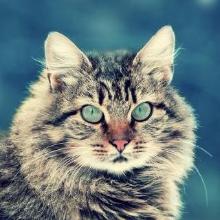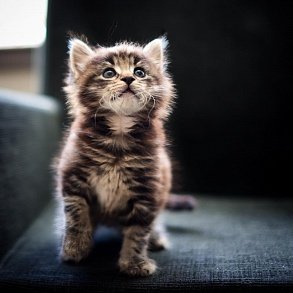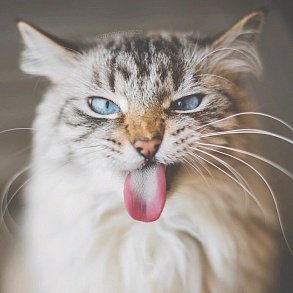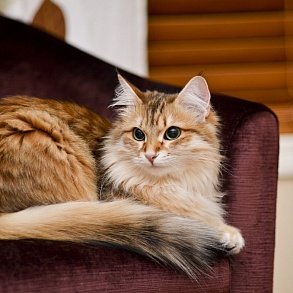Siberian cat

The Siberian cat is the most popular breed in Russia, endowed with countless advantages, the main of which are luxurious appearance, magnificent character, intelligence and devotion.
Brief information
- Breed name: Siberian cat
- Country of Origin: Russia
- Weight: 3,5-12 kg
- Lifetime: 17-20 years old
Highlights
- The Siberian cat is a strong animal, ranging in size from medium to large. Kitties weigh an average of four kilograms, cats – at least six. Sometimes, the weight of the male reaches 12 kg.
- Endowed with great vitality, excellent health, dexterous and courageous.
- They reach true maturity by the age of three or five, live for a long time, sometimes up to 20 years.
- Have a calm character, are friendly, affectionate, but treat strangers with suspicion.
- Siberian cats are independent, tactful and never bother their owners, chasing them on their heels.
- Get along well not only with people, but also with animals that are friendly to them, but their aggressor relatives will immediately be rebuffed.
- They are extremely neat, very clean, and at the same time need grooming. The coat of a well-groomed cat should shine and shine.
- One of the main advantages of the breed is a variety of colors.
Siberian cats , beautiful and respectable, with a magnificent thick coat, have long won popular love, having managed to demonstrate their best qualities in communicating with people. Behind their outward calmness lies confidence and strength, while they are delicate, sensitive and balanced. These cats combine power and grace, tenderness and independence, playfulness and self-esteem.
Breed characteristics
History of the Siberian cat
The image of the Siberian cat – a large, fluffy, healthy animal, with a developed hunting instinct, not afraid of harsh winters, absorbed all the archaic ideas of Russians about the pets of the cat family. For a long time, our compatriots called every large long–haired representative of the feline genus a Siberian cat, whether it was a family pet or a yard robber.
Until the end of the last century, perhaps none of the owners of the Siberian in our country thought about the origin of their pet, implying as a matter of course that the animal's ancestors came from Siberia. But in the 80s, when felinological organizations and clubs of cat lovers began to be created in Russia, the question arose: who are the progenitors of the most popular representatives of the feline genus among the people?
Disputes are still ongoing. There is an opinion that the distant ancestors of true Siberians are norwegian forest cats . They could have been brought to Siberia by immigrants from the northern regions of Russia during the development of this territory, which began in the XVI century. Written references to the so–called Bukhara cats belong to the same period - fluffy strong animals that could be found in all regions of the Russian Empire, and not only in Siberia. They presumably came to Russia together with merchants from Central Asian countries. Bukhara cats are often called relatives of Siberians. It is also possible that domestic cats who found themselves in Siberia could have offspring from wild cats. As a rule, manuls are mentioned among the latter – cute butuzas the size of large domestic cats, owners of the thickest and fluffiest fur among cats.
Most felinologists reject such a concept as a single "native Siberian breed" in general, and unsubstantiated assumptions about the ancestors of the Siberian cat are called myth-making. They point out that in the 80s of the last century, at the beginning of the "cat movement", there was a definition for Siberians in Russia that meant something like the following - "a large cat with thick fur and not white color."
However, whoever the ancestors of domestic cats from the Siberian territories were, initially their genes were not the fundamental link in the breeding of a standardized breed, which began in 1986. During the formation of the breeding core, and this happened mainly in Moscow and St. Petersburg, breeders mainly selected for breeding the largest and furry domestic cats of the "Siberian type" from those that the townspeople brought them to determine the breed. No one went on an expedition to the remote taiga villages of Siberia in search of "true Siberians" at that time, and only a few animals brought from the trans-Ural regions of Russia were registered in the felinological clubs of both capitals. Then there were even proposals to give the breed the name "Moskovskaya".
In the future, representatives of felines from Siberia and the Far East began to be actively involved in breeding work. They were a rather motley exterior group: cats from Krasnoyarsk, Novosibirsk, Kemerovo were distinguished by a specific fine texture of wool, animals of Far Eastern origin were distinguished by a large size, massive backbone, heavy head, long wool of a rough texture. In short, the variety of cats of the "Siberian type" made breeding work on the breeding of the original, truly Russian breed, very painstaking and difficult.
In 1991, the World Cat Federation (WCF) adopted the Siberian cat breed standard developed by the authoritative felinologist Olga Mironova. He was approved as a worker. Three years later, the organization recognized the standard as official.
In 1996, the breed was recognized by the American organization TICA, and a year later Russian breeders achieved recognition of the Siberian breed by another prestigious felinological federation – FIFe.
Today in Russia there are several well-known centers where Siberian cats are bred. The main ones are located in Moscow and St. Petersburg, but cities such as Saratov, Krasnoyarsk, Kirov, Petrozavodsk, Yekaterinburg, Kursk have already joined them, and more than a hundred clubs also work in different regions of the country. We can say that the first truly Russian breed of cats has been formed, but breeders do not stop in their work to consolidate the type of breed, paying special attention to the preservation of the large size of the animal and its massiveness, as well as the quality of the color. One of the colors of the Siberian cat, called " Nevsky masquerade ", allocated by Russian and some international felinological organizations to a separate breed.
It is worth saying that many Siberian and Far Eastern breeders are currently engaged in breeding cats based exclusively on the local population, creating their own lines. However, they do not always have the opportunity to represent their pets at all-Russian exhibitions.
Video: Siberian cat
Appearance of the Siberian cat
Siberian cats have a truly lordly appearance. Quite large in themselves, they look even more impressive thanks to their luxurious wool. A powerful torso with strong muscular paws surprisingly harmonizes with the sweetest elegant muzzle, under which an imposing "frill" flaunts.
Body
The Siberian cat is proportionally built, its massive dense body is of medium length, slightly elongated. The back is powerful, the neck is short, the chest is voluminous.
Head
The shape resembles a wide trapezoid, the muzzle is characterized by a smooth outline. The transition from the forehead to the nose is not sharp. The chin is well defined, the cheekbones are developed, set low, the cheeks are full.
Ears
The ears of the Siberian cat are medium-sized, wide at the base, slightly rounded at the tips. A slight forward tilt is noticeable. The auricle is covered with fur.
Eyes
Expressive, of medium size, have an oval shape, are widely spaced and slightly kosovato. The eyes are painted evenly, their color can be green or yellow of all shades.
Limbs
Muscular, thick, medium length. The paws are large, rounded, with bristly tufts of hair between the fingers.
Tail
The tail of the Siberian cat is of medium length, wide at the base, gradually tapering to a rounded tip. Pubescent evenly, resembles the tail of a raccoon.
Wool
The Siberian cat has a very dense, soft undercoat with a fine texture. It is covered with a coarser covering hair, also quite dense, harsh to the touch. The covering hair evenly covers the back and smoothly falls on the sides and base of the tail of the animal. The coat is shiny, water-repellent. Summer is much shorter than winter. In the warm summer season, a Siberian can look like a shorthair cat, only the tail remains fluffy. In winter, the wool looks very rich, the cat has a luxurious collar, the hind legs are decorated with fluffy "pants", the tail becomes even more pubescent.
Color
The colors of the Siberian cat are solid and patterned. Among the main solid (monophonic) colors of the Siberian are black (exclusively black pigment is represented in the wool) and red (only yellow pigment is present in the wool). Each of these two intense colors corresponds to a lightened analogue: black – blue, red – cream. All cats that have a monochrome color, without exception, all the hairs are dyed evenly from root to tip. Among the intense colors, those that look the most juicy and bright are most appreciated. For lightened analogues of monophonic colors, on the contrary, light, delicate shades are preferred.
There is also a tortoiseshell color – the superimposition of a monochrome black color on a monochrome red and, accordingly, blue – on cream. In this case, spots of black and red or blue and cream colors are evenly distributed throughout the coat. Usually this color is the dignity of females, but sometimes male "turtles" are born, however, as a rule, they are not able to give offspring.
One of the most common colors among Siberian cats is tabby (wild color). In this case, dark and light areas alternate on each hair, forming certain patterns on the animal's wool cover. Three main varieties of this color are recognized in the Siberian breed: marble (classic), brindle, spotted. Each of them has its own color intensity.
The smoky (or smoky) and silvery colors of Siberian cats are also recognized as the standard. In this case, the hairs are not completely colored: they do not have pigmentation at the roots, remaining pure white, then, as they approach the tip, they can be colored black, blue, red, cream, tortoiseshell, cream-blue.
Siberian cats of golden color are very good, whose fur effectively harmonizes with their green eyes. In such cats, part of each hair is colored apricot color.
Rare, but very beautiful is the white color. The so–called colors with white are also recognized, which are divided into 4 main types:
- spotted color - either individual hairs on the neck, chest or abdomen are colored white, or one or more small snow-white spots are present on the wool cover;
- bicolor – from 1/3 to 2/3 of the animal's woolen coat is painted white, ideally, a triangle on the muzzle from the bridge of the nose down, breast, belly, inner part of the limbs should be white;
- harlequin – white color extends to 2/3-5/6 of the wool cover, the tail remains colored, small spots on the head, shoulders, back, hips;
- van – the cat is almost all white, except for the tail and two spots on the head behind the ears.
The following colors are not recognized as the standard: Abyssinian tabby, chocolate, cinnamon (close to the color of cinnamon), purple, fawn (light beige) and their derivatives.
Color-point color is allocated by domestic felinologists to a separate breed – Neva masquerade , however, it is not yet recognized by all international associations.
Disadvantages of the breed
- Excessively elegant constitution: elongated or too short body, fragile backbone, long thin limbs, small paws, long, aristocratic neck.
- Narrow muzzle, flat cheeks, high cheekbones, weak chin, flat profile.
- Small eyes, as well as perfectly round and deep-set.
- Large ears placed at a short distance from each other, as well as too small ears, excessively pubescent.
- The tail is too short or too long, its pubescence is not intense.
- Lack of undercoat or overgrown undercoat.
- Patchy coat, devoid of luster.
- No tufts of fur between the fingers.
Siberian cat photo
Character of the Siberian cat
Siberian cats are mobile and playful, love to play with babies and are very attached to their owners. At the same time, they have a pronounced sense of self-esteem, are not very "talkative", sometimes behave wilfully and are subject to mood swings. If the cat does not reciprocate the caresses of the owner, it is better to leave it alone. In turn, having a developed sense of tact, she herself will never impose on the owner if she notices that he is not in the mood or busy with something. But she can make anyone laugh by showing her funny habit of basking on her back, taking funny poses. It is also touching how this animal likes to sleep, sprawled on its back and lifting up its front paws.
Siberians have a strong character, but they do not seek to dominate relationships with other animals, which are usually friendly. These cats are fearless, but they prefer not to communicate with strangers, showing undisguised suspicion towards them.
They are hardy and unpretentious to living conditions: they feel great both in urban conditions and in country houses, although they prefer, of course, space and will. These cats are natural hunters, and you won't find rodents where they run the place.
If a Siberian cat lives in a city apartment, it is advisable to walk it at least once a week, as it is very inquisitive, likes to explore new territories and needs physical activity. These cats like to observe the terrain from elevations, so they really like to settle on cabinets, bookshelves, and are not indifferent to chandeliers.
Care and maintenance
Caring for a Siberian cat will not take much time. They are very clean and tidy, they get used to the toilet quickly.
The coat of Siberians is not too light and soft, so it does not roll into tangles, but they still need regular combing. It is advisable to do this procedure once a week, but in spring and autumn, during molting, it is better to comb the cat more often.
To care for your pet's fur, you need to purchase a special comb for long hair. In the process of combing, dead hairs and skin scales are removed, touching the comb to the skin stimulates blood circulation. The cat needs to be accustomed to this procedure gradually, rewarding patience with a treat. Over time, this ritual, which strengthens the trusting relationship between the owner and the pet, will become pleasant and expected for the animal.
The Siberian cat should not be washed often, because it is able to keep its fur clean by itself. But after a trip to nature, it is still desirable to bathe the animal. Despite the fact that Siberians are not afraid of water and can even fish, they do not really like bathing, so it is better to carry out this procedure together.
You can bathe the cat in the bathroom or in a large basin. Put a rubber mat on the bottom, then pour water (level – 6-8 cm, temperature – 38-39 ° C). It is better to close the animal's ears with cotton wool. After putting the cat in the water, use a sponge to soak the fur with water, without touching the head, rub the shampoo intended for long-haired cats. Rinse off the shampoo with warm water, wrap the animal in a large terry towel and let it dry in a warm room where there should be no drafts.
Washing can be replaced by dry cleaning. There are special powders for this. They are plentifully applied to the wool, after which it is carefully combed.
Regularly clean the ears of the animal with a swab, clean the eyes with wet cotton wool. The claws of the Siberian cat do not need to be cut, it is enough to buy a scratching post.
Siberians are not picky in food. Having an excellent appetite, they can abuse the love of their owners, who find it difficult to refuse pets an additional treat. However, you should not follow the furry extortionists, because the excessive weight of a Siberian cat can lead to a reduction in its life span, as well as liver disease.
Siberians prefer to eat raw natural products. Raw lean meat, poultry (chicken, turkey), sea fish are useful for them. As a treat, you can treat a cat with boiled squid or shrimp. Many Siberian cats simply adore shrimps and are even ready to go to blackmail for them, defiantly refusing to eat other foods.
Periodically, these cats should be given egg yolk, low-fat cottage cheese and fermented baked milk, cheese (not smoked). Cream, the fat content of which should be no more than 10%, is useful for pregnant and nursing cats and grown-up kittens. Cow's milk is an undesirable product, but goat's milk is quite suitable.
Teach the Siberian to porridge – rice, buckwheat, hercules.
In addition to the basic diet, you can add premium dry food, but in limited quantities, in the form of treats. They contain vitamins and trace elements, in addition, dry food is a good tool for brushing teeth and removing the wool swallowed by the animal from the body.
Health and diseases of the Siberian cat
Siberian cats have good health. The main danger for her may be urolithiasis and the ingress of wool into the intestines. Urolithiasis is very dangerous, as it often leads to kidney failure. The animal usually gets rid of the fur in the intestines by itself due to the gag reflex, but you can help him by forcing him to drink vegetable oil (not castor oil). For an adult cat, a tablespoon is enough, for a kitten – no more than a teaspoon.
If a Siberian is alone or motionless for a long time, he may develop hyperexcitability or hyperactivity.
In old age, Siberians may develop shortness of breath, slowness, lethargy, cough, which, as a rule, indicates heart and vascular diseases. In such cases, it is necessary to contact a veterinarian.
How to choose a kitten
When choosing a Siberian kitten, it is worth remembering that this breed is distinguished by a variety of colors. Many unscrupulous sellers use this and sell kittens of unknown origin under the guise of Siberian kittens, so it is better not to buy from the hands of a Siberian.
For a thoroughbred Siberian kitten, you should go to a kennel or to a breeder with a good reputation. It is better to buy babies who are already 3.5 months old. They should be moderately well-fed, well-groomed, active, curious. The kitten's fur should shine, the eyes should shine. It is desirable that the kid you like has a reciprocal feeling for you. To check this, take him in your arms – he should feel comfortable, not break out and not worry.
A kitten at the age of 3-4 months almost completely meets the standard of the Siberian breed, but there are some nuances. His fur is still soft, "infant", the ears can be placed a little closer than it should be – this should change with age. The baby is supposed to have documents with information about vaccinations made to him, and you should also be given the pedigree of the animal.
If you need a kitten for breeding or you want your Siberian to participate in exhibitions, you need to buy a baby in clubs belonging to one of the official international felinological organizations, for example, WCF, FIFe. In independent clubs, approaches to breed standards are often also "independent".
Photos of Siberian kittens
How much does a Siberian cat cost
Prices for Siberian cats in Russia are quite democratic. At the market or by acquaintance, a kitten without documents can be bought for $20. Pedigreed kittens with pedigree in clubs, kennels, breeders cost from $70 to $350 – depending on the class and rarity of the color.


